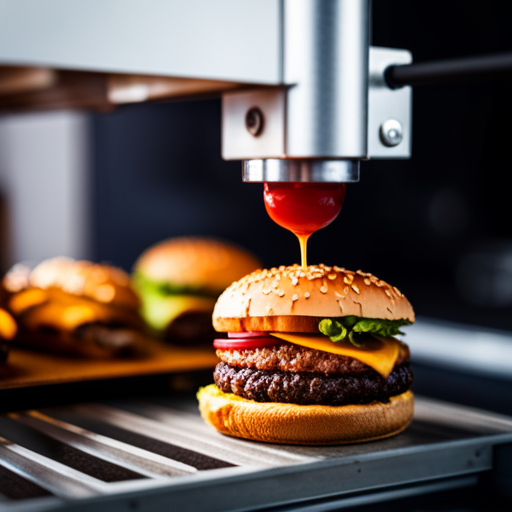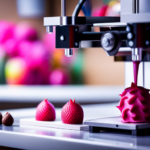Did you know that by 2050, the global population is projected to reach 9.7 billion, demanding a 70% increase in food production?
The emergence of 3D printed food has sparked ethical debates, encompassing environmental impact, safety, accessibility, nutritional implications, and cultural significance.
This article delves into the multifaceted ethical considerations surrounding 3D printed food, shedding light on the complexities and implications for the future of food systems.
Environmental Impact of 3D Printed Food
The environmental impact of 3D printed food is a critical consideration in assessing the ethical implications of this emerging technology.
One of the potential advantages of 3D printed food is its ability to revolutionize the supply chain. By enabling the production of food on-site or even at home, it could reduce the need for large-scale agricultural operations and long transportation routes, thereby cutting down on greenhouse gas emissions and energy consumption.
Additionally, 3D printed food has the potential to significantly reduce waste in the food industry. With traditional food production, a substantial amount of food is wasted due to factors such as spoilage, over-purchasing, and inefficiencies in the supply chain. 3D printing allows for precise ingredient measurements, reducing the likelihood of unused or spoiled food.
However, while these potential benefits are promising, it is essential to thoroughly consider the entire lifecycle of 3D printed food, including the environmental impact of the materials used in the printing process and the energy consumption involved. Moving forward, it is crucial to address these environmental considerations to ensure that 3D printed food offers a net positive environmental impact.
This discussion naturally leads to the subsequent section which delves into safety and regulatory concerns.
Safety and Regulatory Concerns
Considering the potential environmental benefits of 3D printed food, it is crucial to address safety and regulatory concerns to ensure the technology’s overall ethical implications are thoroughly evaluated. The following points are essential to consider:
-
Regulatory Compliance: 3D printed food must adhere to food safety regulations and standards set by government agencies to ensure that the materials used, production processes, and final products meet the necessary safety requirements.
-
Consumer Confidence: Building trust among consumers is vital for the widespread acceptance of 3D printed food. Transparency in the sourcing of ingredients, production methods, and safety testing will be crucial in gaining consumer confidence.
-
Quality Control: Implementing rigorous quality control measures throughout the 3D food printing process is fundamental to guarantee the safety and integrity of the final products.
-
Health Impact Assessment: Conducting thorough health impact assessments to understand the potential effects of 3D printed food on consumers’ health and well-being is imperative for regulatory compliance and consumer confidence.
Addressing these safety and regulatory concerns is essential to ensure that 3D printed food meets the necessary standards for consumer safety and ethical production.
Accessibility and Equity Considerations
Accessibility and equity considerations are crucial aspects in evaluating the ethical implications of 3D printed food. As this technology advances, it is important to consider how it will be accessible to and impact different populations. Equitable distribution and affordability challenges are key factors in ensuring that 3D printed food benefits society as a whole, rather than exacerbating existing inequalities.
| Consideration | Description | Implications |
|---|---|---|
| Equitable Distribution | Ensuring fair and even distribution of 3D printed food to avoid favoring certain demographics. | Addressing disparities in access to nutritious food, promoting social equality, and reducing food insecurity. |
| Affordability Challenges | Addressing the cost barriers that may limit access to 3D printed food for certain populations. | Ensuring that the technology benefits everyone, regardless of economic status, and avoiding widening the gap between socioeconomic groups. |
These considerations highlight the need for proactive measures to address potential inequalities and ensure that 3D printed food contributes to a more equitable and accessible food system. By prioritizing accessibility and equity, the ethical implications of 3D printed food can be more effectively managed and the technology can be harnessed for the benefit of all.
Nutritional Quality and Health Implications
An essential consideration for 3D printed food technology is its impact on the nutritional quality and health implications of the food produced. This innovative technology has the potential to revolutionize the way we consume food, but it is crucial to evaluate its nutritional value and food safety implications.
When considering the nutritional quality and health implications of 3D printed food, several key points should be taken into account:
-
Nutrient Retention: The 3D printing process may impact the retention of essential nutrients in the printed food, potentially affecting its overall nutritional value.
-
Customization: 3D printed food allows for personalized nutrition, enabling individuals to tailor their food choices to meet specific dietary needs and preferences.
-
Food Safety: Ensuring that 3D printed food meets stringent food safety standards is imperative to prevent any adverse health implications.
-
Health Impact: Research is needed to assess the long-term health implications of consuming 3D printed food to guarantee that it contributes to overall well-being.
As 3D printed food continues to develop, it is vital to address these considerations to optimize its nutritional quality and ensure positive health implications for consumers.
Social and Cultural Impact on Food Systems
Addressing the social and cultural impact on food systems, it is imperative to recognize the potential influence of 3D printed food technology on dietary habits and culinary traditions. The introduction of 3D printed food has the potential to challenge cultural norms and dietary diversity. It could lead to a shift in the way people perceive and consume food, impacting longstanding culinary traditions and social dining practices.
| Cultural Norms | Dietary Diversity | Social Integration |
|---|---|---|
| 3D printed food may challenge traditional cooking methods and recipes, potentially altering cultural norms around food preparation and consumption. | The technology could provide new options for individuals with dietary restrictions, potentially enhancing dietary diversity and inclusivity. | The introduction of 3D printed food could change the way people come together to share meals, impacting social integration and communal dining experiences. |
The potential changes brought about by 3D printed food technology necessitate careful consideration of the social and cultural implications to ensure that the technology aligns with the values and practices of diverse communities.
Frequently Asked Questions
How Does 3D Printed Food Affect the Job Market in the Food Industry?
3D printed food has the potential to impact employment in the food industry by altering market competition. As this technology evolves, it may lead to shifts in job roles and the emergence of new opportunities.
What Are the Potential Implications of 3D Printed Food on Traditional Cooking and Culinary Skills?
The potential implications of 3D printed food on traditional cooking and culinary skills are vast. Culinary creativity may shift towards designing digital recipes, and cooking innovation could focus on optimizing 3D printing techniques for food production.
How Does 3D Printed Food Impact Food Waste and Sustainability Efforts?
3D printed food has the potential to revolutionize food preservation and reduce food waste, thus positively impacting sustainability efforts. Its environmental impact can be significant, offering innovative solutions to global food challenges.
What Are the Ethical Considerations Surrounding the Use of 3D Printed Food in Humanitarian Aid and Disaster Relief Efforts?
Ethical implications in utilizing 3D printed food for humanitarian aid and disaster relief efforts are complex. Balancing access, cultural sensitivity, and nutritional needs while ensuring safety and efficacy presents multifaceted challenges that require careful consideration and ethical guidelines.
What Are the Cultural and Social Implications of 3D Printed Food in Different Regions and Societies?
Cultural adaptation and social acceptance are crucial aspects to consider when exploring the implications of 3D printed food in different regions and societies. Understanding local customs and food practices will be essential for successful integration.
Conclusion
In conclusion, the ethics of 3D printed food present complex considerations across environmental, safety, accessibility, nutritional, and social dimensions.
Similar to a intricate tapestry, the implications of 3D printed food weave together a web of interconnected ethical dilemmas.
As this technology continues to advance, it is imperative to carefully navigate these ethical considerations in order to ensure the responsible and sustainable integration of 3D printed food into our food systems.


